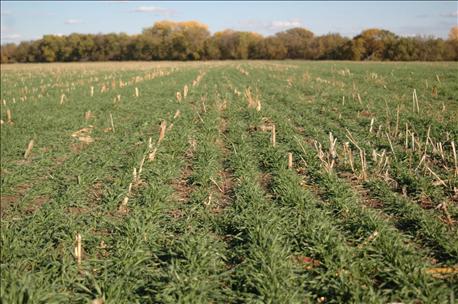
In previous columns, we've talked about how far we've come in mitigating soil erosion, and that we've still got some room for improvement in building an ag landscape that's better able to handle extreme weather events — whether it be heavy rainfall or drought.
The next question is: What's the next step, and how do you know if you're seeing an improvement?
One indicator in southeast Nebraska in recent years is the amount of runoff seen on slopes and hillsides, and the color of runoff. If you're seeing water with a chocolate-brown color running off your fields, it's an indicator of soil loss.

GOOD STARTING PLACE: When trying cover crops for the first time, it's best to try something that has a high probability for success. Cereal rye is one of the easiest and least expensive covers to establish, and growers can still expect to see green growth in spring even after planting in December.
What's the next step? We've heard a lot about cover crops over the last 10 years, but every situation and every farm is different. A grower in southeast Nebraska with rain-fed corn and soybeans is working with different challenges, soil types and topography, than a grower in southwest Nebraska with irrigated corn, soybeans and wheat. In addition, crop rotation makes a big difference in opportunities for establishing a cover crop or forage crop at different times of the year.
Take baby steps
Consider this scenario. If I'm a corn and soybean grower in eastern Nebraska who has been no-tilling for several years and have tile outlet terraces installed, what's the next step? When you're farming north of I-70, it can be a tough call on what to plant postharvest and still see results before winter sets in.
"My approach is, let's take baby steps. Let's do something where we have a high probability for success, and then we can build on that success," says Keith Glewen, Nebraska Extension educator. "I think here in eastern Nebraska, the first step is planting cereal rye or triticale after corn harvest followed by no-tilling soybeans into the cover crop."
When planting in the first week of November after corn harvest, growers likely won't see cereal rye or triticale emerge before winter sets in. However, cereal rye or triticale will have emerged by early spring, providing some extra cover for when those heavy spring rains come.
"In the last two years, I've had people who planted cereal rye or triticale tell me that they experienced the same rainfall and runoff, but the runoff wasn't the dark-chocolate color other growers were dealing with; it was clear," Glewen says. "If you improve infiltration as a result of development of soil aggregates, you're going to reduce the amount of water coming off the field and the erosion potential. Those root system dynamics have a great impact on the soil quality or soil health over the short and long term."
A good place to start
Cereal rye is considered one of the easiest and most inexpensive cover crops to establish. It's known for its fibrous root system, its biomass production and its winter-hardiness, so you can still expect to see green growth in spring even if you plant in December. It's also a great nitrogen scavenger, which helps prevent nutrients from leaving the farm.
When it comes to planting a cover crop, Paul Jasa, Nebraska Extension engineer, notes fear of the unknown is one of the biggest hurdles producers have to overcome. In a state like Nebraska, where next year's weather is anyone's guess, it's tough to say how successful a cover crop planting will be.
"At harvest this year, I'm just guessing what's going to happen next year," Jasa says. "What's the risk if you don't get the rain you need? Then you've wasted $35-per-acre worth of seed. But with cereal rye, there's minimal risk of failure."
Jasa also advises growers to start small and plant cover crops where they will be seen, so they are more likely to invest time and attention needed for a successful cover crop. "If you plant the cover crop in the Back 40, the farmer may not pay as much attention to it," Jasa says.
About the Author(s)
You May Also Like






